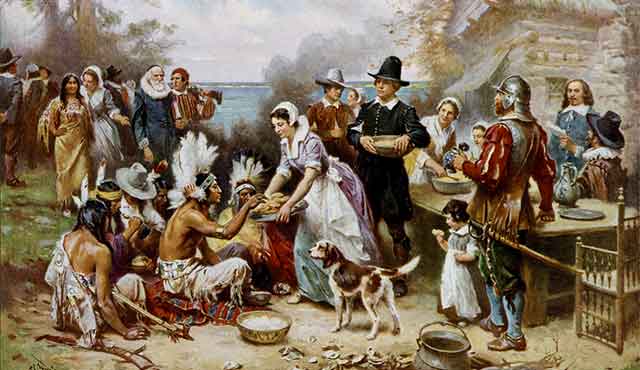The history of Thanksgiving, as most Americans remember being taught, begins with the Pilgrim settlers at the Plymouth Colony having a nice big lunch with their new neighbors and offering prayers of gratitude for a bountiful harvest. Then came the Butterball turkey and the National Football League and voilá! The holiday as we know it was complete.
That’s the Cliff’s Notes version. The full story involves a really nasty winter, a couple of very significant wars, two very significant presidents, a nursery rhyme and almost 400 years.
The first settlers of the Plymouth Colony in the early 17th century were definitely hardy pioneers, but they didn’t have much of a clue as to how to survive in their new surroundings. Nearly half the population of the colony died during the brutal winter of 1620. Deciding that a little local knowledge couldn’t hurt, the settlers formed a relationship with the neighboring Wampanoag tribe, who taught them to grow varieties of corn, squash and beans, catch fish, hunt and collect seafood. By the harvest season of 1621, the colonists had grown, killed or caught plenty of food to see them through the winter. In gratitude, they sat down and feasted with the Wampanoag for three days.

Fanciful paintings of the feast showing the tables groaning under the weight of huge roast turkeys are probably inaccurate, according to historical researchers. The more likely menu included items that came more easily to hand in what would become Massachusetts: goose, corn, codfish and lobster.
This “first Thanksgiving” gave way in later years to more religiously based days of fasting, prayer and thanksgiving at various times throughout the year. Still later, the governors of the first colonies would declare days of thanksgiving in the autumn, but there were no formal declarations.
During the Revolutionary War, the Continental Congress in 1777 decreed that all 13 of America’s colonies celebrate a national day of thanksgiving for the victory of the Continental Army over the British at Saratoga. This day continued to be celebrated by many states into the middle of the next century, but the date could vary by several weeks or even months.
The woman who would do the most to change that was a novelist, poet and America’s first female magazine editor: Sarah Josepha Hale. Hale believed strongly in a thanksgiving day that would be celebrated by all states at the same time—a true national holiday. She wrote to presidents Zachary Taylor, Millard Fillmore, Franklin Pierce and James Buchanan, attempting to persuade them to declare an official national day of thanksgiving—all without success.
It took the Civil War to produce the necessary sentiment. Hale’s letter to Abraham Lincoln persuaded the president to support legislation establishing the holiday in 1863. He signed the bill into law four months after the Battle of Gettysburg, declaring the last Thursday of November to be Thanksgiving Day. It was considered a unifying event after the divisiveness of the Civil War.
Thanksgiving Day may be Hale’s most celebrated legacy, but children throughout America are familiar with a poem she wrote that was included in her book “Poems for Our Children,” published in 1830: “Mary Had a Little Lamb.” Thomas Edison spoke the opening lines of “Mary Had a Little Lamb” as the first speech ever recorded on his newly invented phonograph in 1877—the same year Sarah Josepha Hale retired as a magazine editor at age 89. She died two years later.
In the 20th century, Thanksgiving Day was considered to mark the beginning of the Christmas shopping season, which became crucial to the success of many American businesses. Wanting to stoke the Depression-era economy even further, President Franklin D. Roosevelt moved the holiday up a week, extending the shopping season. Some states observed what came to be called “Franksgiving,” but most clung doggedly to the feast day declared by Lincoln. Congress broke the deadlock in 1941: the holiday would officially fall on the fourth Thursday of November.
Stuck for a good Thanksgiving toast after prayers over the feast? It’s difficult to do better than Hilaire Belloc, the early 20th century Catholic Anglo-French writer and historian:
“Wherever the Catholic sun doth shine,
There’s always laughter and good red wine.
At least I’ve always found it so.
Benedicamus Domino!”


